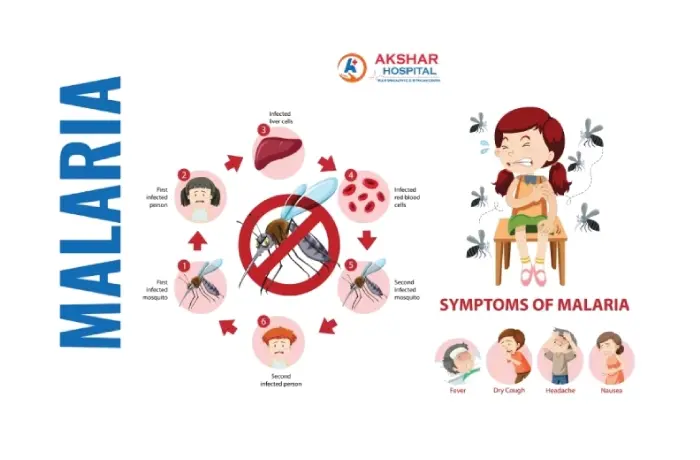
Welcome to our comprehensive guide on understanding and managing malaria. Malaria is a severe mosquito-borne disease that affects millions of people worldwide.
This article will delve into essential topics such as malaria symptoms and treatment, risk factors, and effective home remedies.
Whether you're looking to identify the symptoms of malaria, understand the risk factors, or explore treatment options, we've got you covered.
Stay informed and empowered with our expert insights on malaria prevention and management. Read on to discover the critical information you need to safeguard your health.
What is Malaria and How it Happens
Malaria is a complex and widespread tropical disease that affects millions of people globally, particularly in regions with a high prevalence of the disease.
This illness is caused by a group of parasites known as Plasmodium, with several species capable of infecting humans.
How Malaria Occurs
The transmission of malaria primarily occurs through the bite of female Anopheles mosquitoes that are carrying Plasmodium parasites.
When an infected mosquito bites a person, it injects these microscopic parasites into the individual's bloodstream.
Once inside the body, the parasites embark on a journey. They first travel to the liver, where they mature and multiply.
After this liver stage, they re-enter the bloodstream and infect red blood cells. Inside these blood cells, the parasites continue to multiply, causing the cells to burst.
This release of parasites into the bloodstream triggers the characteristic symptoms of malaria.
Factors Contributing to Malaria
Several key factors contribute to the occurrence of malaria:
- Mosquito Bites: The most common mode of transmission is through the bite of infected Anopheles mosquitoes. These mosquitoes thrive in tropical and subtropical regions.
- Geographical Location: Malaria is prevalent in many parts of Africa, Asia, and South America, where the climate supports mosquito breeding.
- Travel to Endemic Areas: People who travel to regions with high malaria transmission rates without adequate protection are at risk of contracting the disease.
- Contaminated Blood Transfusions: In rare cases, malaria can be transmitted through blood transfusions or organ transplants from infected donors.
- Mother-to-Child Transmission: Pregnant women with malaria can transmit the disease to their unborn children, leading to congenital malaria.
- Plasmodium Species: Different Plasmodium species cause varying degrees of severity in malaria cases. Plasmodium falciparum is one of the most deadly species.
Understanding how malaria occurs and the factors contributing to its transmission is critical for prevention, early diagnosis, and effective treatment.
Malaria can lead to severe complications and even be fatal if left untreated. Hence, raising awareness about this disease and implementing preventive measures, such as mosquito nets, insect repellents, and antimalarial medications, is essential in regions where malaria is endemic.
Common Symptoms of Malaria
Malaria is a parasitic infection that can manifest with a range of symptoms, often resembling flu-like illness.
Recognizing these symptoms is crucial for timely diagnosis and treatment. Here's a detailed look at the common symptoms associated with malaria:
- Fever: One of the hallmark symptoms of malaria is a recurring high fever. The fever often comes in waves, with chills and shivering followed by a sudden rise in temperature. This cyclical pattern is a key indicator of malaria.
- Headache: Malaria commonly presents with severe headaches, which can be persistent and throbbing. This symptom can be quite debilitating.
- Fatigue: Malaria can lead to extreme tiredness and fatigue, making it challenging to perform daily activities.
- Muscle and Joint Pain: Many individuals with malaria experience muscle and joint pain, which can be severe and contribute to overall discomfort.
- Nausea and Vomiting: Malaria can cause nausea and vomiting, leading to dehydration and further weakness.
- Sweating: Profuse sweating is often observed during fever episodes in malaria. Patients may wake up drenched in sweat after experiencing chills.
- Abdominal Pain: Some individuals may develop abdominal pain and discomfort, which can be mistaken for gastrointestinal issues.
- Anemia: In severe cases, malaria can lead to anemia due to the destruction of red blood cells by the parasites. Anemia can cause pale skin, weakness, and shortness of breath.
- Confusion and Cognitive Changes: Severe malaria, particularly caused by Plasmodium falciparum, can affect the brain, leading to confusion, seizures, and impaired consciousness. This is a medical emergency.
- Yellowing of the Skin and Eyes (Jaundice): In certain cases, malaria can lead to jaundice, characterized by yellowing of the skin and the whites of the eyes.
It's important to note that the specific symptoms and their severity can vary depending on the type of Plasmodium parasite responsible for the infection.
Additionally, some symptoms of malaria can overlap with those of other diseases like dengue fever, making accurate diagnosis essential.
Different types of malaria, such as Plasmodium falciparum, Plasmodium vivax, Plasmodium malaria, and Plasmodium ovale, can have varying incubation periods and symptom profiles.
Therefore, seeking prompt medical attention upon experiencing any of these symptoms, especially if you've recently traveled to a malaria-endemic area, is crucial for early diagnosis and effective treatment.
Remember, malaria is a serious disease, but with timely intervention, it can be successfully treated.
Malaria Treatment Options
Malaria is a serious disease caused by Plasmodium parasites and can have life-threatening complications if not treated promptly and correctly.
Treatment for malaria depends on several factors, including the type of Plasmodium parasite causing the infection, the severity of the illness, and the patient's age and overall health. Here is a detailed look at malaria treatment options:
1. Antimalarial Medications
The cornerstone of malaria treatment is antimalarial medications.
The choice of medication depends on the species of Plasmodium causing the infection and its susceptibility to specific drugs.
Commonly used antimalarials include chloroquine, artemisinin-based combination therapies (ACTs), quinine, mefloquine, and atovaquone-proguanil.
Resistance to certain antimalarials is a growing concern, so treatment guidelines may change over time.
2. Symptomatic Treatment
Along with antimalarial drugs, treatment often includes medications to manage specific symptoms.
For instance, fever-reducing medications like acetaminophen (paracetamol) can help alleviate fever and discomfort.
3. Hospitalization for Severe Malaria
Severe malaria, especially when caused by Plasmodium falciparum, is a medical emergency.
Patients with severe malaria may require hospitalization for close monitoring and intravenous (IV) treatment.
In severe cases, treatments such as artesunate IV are preferred due to their rapid action.
4. Preventive Measures
Prevention is an essential aspect of malaria management. Preventive measures include the use of insecticide-treated bed nets, insect repellents, and chemoprophylaxis (taking antimalarial medications before and during travel to endemic areas).
Preventive strategies also involve efforts to control mosquito populations, such as indoor residual spraying.
5. Prompt Diagnosis and Early Treatment
Timely diagnosis and treatment are critical for successful malaria management.
Diagnostic tests, such as blood smears and rapid diagnostic tests (RDTs), help confirm the presence of malaria parasites in the patient's blood.
Early treatment can prevent the disease from progressing to severe malaria, reducing the risk of complications.
6. Follow-Up Care
After initial treatment, patients should undergo follow-up assessments to ensure the complete clearance of the parasites from their bloodstream.
Completing the full course of prescribed antimalarial medications is crucial to prevent relapse and the development of drug-resistant parasites.
7. Guidelines for Malaria Treatment
Malaria treatment guidelines are established by health authorities and organizations to standardize and optimize treatment practices.
These guidelines are periodically updated to account for emerging drug resistance patterns and new treatment options.
Malaria treatment involves a combination of antimalarial medications, symptomatic relief, preventive measures, and, in severe cases, hospitalization.
Early diagnosis and adherence to treatment guidelines are essential to effectively manage malaria and reduce its impact on individuals and communities.
If you suspect you have malaria or are traveling to a malaria-endemic area, it's crucial to seek medical advice and follow preventive measures to protect yourself from this potentially life-threatening disease.
Treatment for Malaria at Home
While malaria is a serious disease that often requires medical intervention, there are certain measures you can take at home to alleviate symptoms and aid in the recovery process.
It's important to note that home treatment for malaria should be considered a temporary measure until you can seek proper medical care, especially if the symptoms are severe or if you suspect you have contracted malaria.
Here's a detailed guide on home treatment for malaria:
1. Rest
One of the most important aspects of malaria home treatment is getting plenty of rest.
Fatigue is a common symptom of malaria, and rest helps your body recover and fight off the infection.
2. Stay Hydrated
Malaria can cause fever, sweating, and vomiting, leading to dehydration.
Drink plenty of fluids, including water, oral rehydration solutions, and clear soups, to stay hydrated.
3. Manage Fever
Over-the-counter fever-reducing medications like acetaminophen (paracetamol) can help reduce fever and alleviate discomfort.
Follow the recommended dosage instructions and avoid exceeding the recommended dose.
4. Maintain a Cool Environment
Malaria can cause fever and chills, so keeping the room temperature comfortable is essential.
Use fans, open windows, or take tepid sponge baths to cool down if needed.
5. Prevent Mosquito Bites
Even while at home, continue to protect yourself from mosquito bites.
Use bed nets treated with insect repellent, wear long-sleeved clothing, and use mosquito repellent on exposed skin.
6. Monitor Symptoms
Keep a close eye on your symptoms and any changes in your condition.
If symptoms worsen or new symptoms develop, seek medical attention promptly.
7. Seek Medical Care
While home treatment can help manage mild malaria symptoms, it is not a substitute for professional medical care.
If you suspect you have malaria or experience severe symptoms, such as confusion, seizures, or difficulty breathing, seek immediate medical attention.
8. Follow Medical Advice
If you receive a diagnosis of malaria from a healthcare provider, it is crucial to follow their prescribed treatment plan.
Complete the full course of prescribed antimalarial medications, even if you start feeling better before the medication is finished.
9. Preventive Measures
After recovering from malaria, take measures to prevent future infections.
Continue to use mosquito nets, insect repellents, and other preventive methods.
Remember that while home treatment can help manage mild symptoms, malaria can progress rapidly to a severe and life-threatening stage. Early diagnosis and appropriate medical treatment are essential for a full recovery and to prevent complications. If you suspect malaria, it is always advisable to consult a healthcare professional for a proper diagnosis and treatment plan.
Medical Approaches to Reduce Malaria
Malaria, a mosquito-borne disease caused by Plasmodium parasites, continues to pose a significant global health challenge.
To combat this infectious disease, various medical approaches have been developed to reduce its prevalence and impact. Here's a comprehensive look at these approaches:
1. Prevention
Prevention plays a critical role in reducing malaria transmission. Key preventive measures include:
- Insecticide-Treated Bed Nets: Sleeping under bed nets treated with insecticides helps protect individuals from mosquito bites, especially during nighttime when Anopheles mosquitoes are most active.
- Indoor Residual Spraying: Spraying insecticides inside homes, particularly in high-risk areas, can reduce mosquito populations and prevent them from transmitting the disease.
- Chemoprophylaxis: Individuals traveling to malaria-endemic regions can take antimalarial medications before and during their trip to prevent infection.
2. Early Diagnosis and Treatment
Early detection and treatment are crucial for managing malaria effectively and preventing severe cases.
Diagnostic tests, such as blood smears and rapid diagnostic tests (RDTs), help confirm the presence of malaria parasites in the bloodstream.
Timely administration of appropriate antimalarial medications is essential to clear the parasites from the body.
The choice of medication depends on the Plasmodium species and drug resistance patterns in the region.
3. Malaria Medical Management
Malaria management involves a comprehensive medical approach that includes:
- Antimalarial Medications: A range of antimalarial drugs, such as chloroquine, artemisinin-based combination therapies (ACTs), and quinine, are used to treat malaria.
- Severe Malaria Treatment: Severe malaria, often caused by Plasmodium falciparum, requires immediate hospitalization and intravenous (IV) medications like artesunate to save lives.
- Follow-Up Care: Patients are monitored to ensure complete parasite clearance and prevent recurrence.
4. Vector Control
Reducing the population of Anopheles mosquitoes, the malaria vector, is a key strategy.
Apart from insecticide-treated bed nets and indoor spraying, environmental management, like eliminating breeding sites, can help reduce mosquito populations.
5. Vaccination
The development of a malaria vaccine, such as the RTS, S/AS01 (Mosquirix), offers promise in preventing the disease.
Vaccination programs are being introduced in some endemic areas to provide additional protection, particularly for children.
6. Public Health Interventions
Public health campaigns, education, and community engagement are critical in raising awareness about malaria prevention and treatment.
Surveillance systems help track and respond to outbreaks promptly.
Three Stages of Malaria
Malaria infection typically progresses through three stages:
- 1. The Asymptomatic Stage: Initially, infected individuals may not show symptoms, making early diagnosis challenging.
- 2. The Acute Stage: Symptoms such as fever, chills, and fatigue appear during this stage, leading to diagnosis.
- 3. The Severe Stage: Severe malaria can develop rapidly if not treated, with complications like organ failure, anemia, and neurological symptoms.
By combining these medical approaches and focusing on malaria prevention, diagnosis, and treatment, the global community can significantly reduce the burden of this disease, especially in regions where malaria is endemic.
Collaboration between governments, healthcare organizations, and communities is vital to achieving effective malaria control and eventual eradication.
Final Words on Malaria Disease
In the battle against malaria, knowledge and proactive measures are our strongest allies.
Malaria prevention begins with simple yet effective practices like using bed nets, wearing protective clothing, and using insect repellents.
For travelers to endemic areas, prophylactic medications can be lifesaving. Early diagnosis and prompt medical treatment are paramount, as malaria can progress rapidly, leading to severe complications if left unchecked.
Pregnant women, children, and those with compromised immune systems must take extra precautions.
In cases of severe symptoms or delayed relapses, seeking immediate medical attention can be the difference between life and death.
Frequently Asked Questions (FAQ)
Malaria is spread to humans through bites from female Anopheles mosquitoes. These mosquitoes need blood from humans to lay their eggs, and this connection between humans and mosquitoes is vital in the parasite's life cycle.
The primary risk factor for getting malaria is residing in or traveling to regions where the disease is widespread. These areas are typically found in tropical and subtropical regions like Sub-Saharan Africa, South Asia, and Southeast Asia.
Yes, there is a malaria vaccine called RTS, S/AS01, but it provides partial protection and is mainly recommended for children in high-risk areas. Other preventive measures like bed nets and medications are still essential.
Krintafel (tafenoquine) is indeed a relatively new drug designed to prevent relapse of malaria caused by Plasmodium vivax (P. vivax) infection. Its longer duration of action compared to traditional medications has the potential to improve treatment adherence and reduce the risk of malaria recurrence, addressing a significant challenge in managing P. vivax malaria.
Higher malaria prevalence in African countries has correlated with lower COVID-19 rates, possibly due to innate immunity stimulation. This suggests innate immune system modulation as a potential protective mechanism against SARS-CoV-2. Further research is ongoing.




